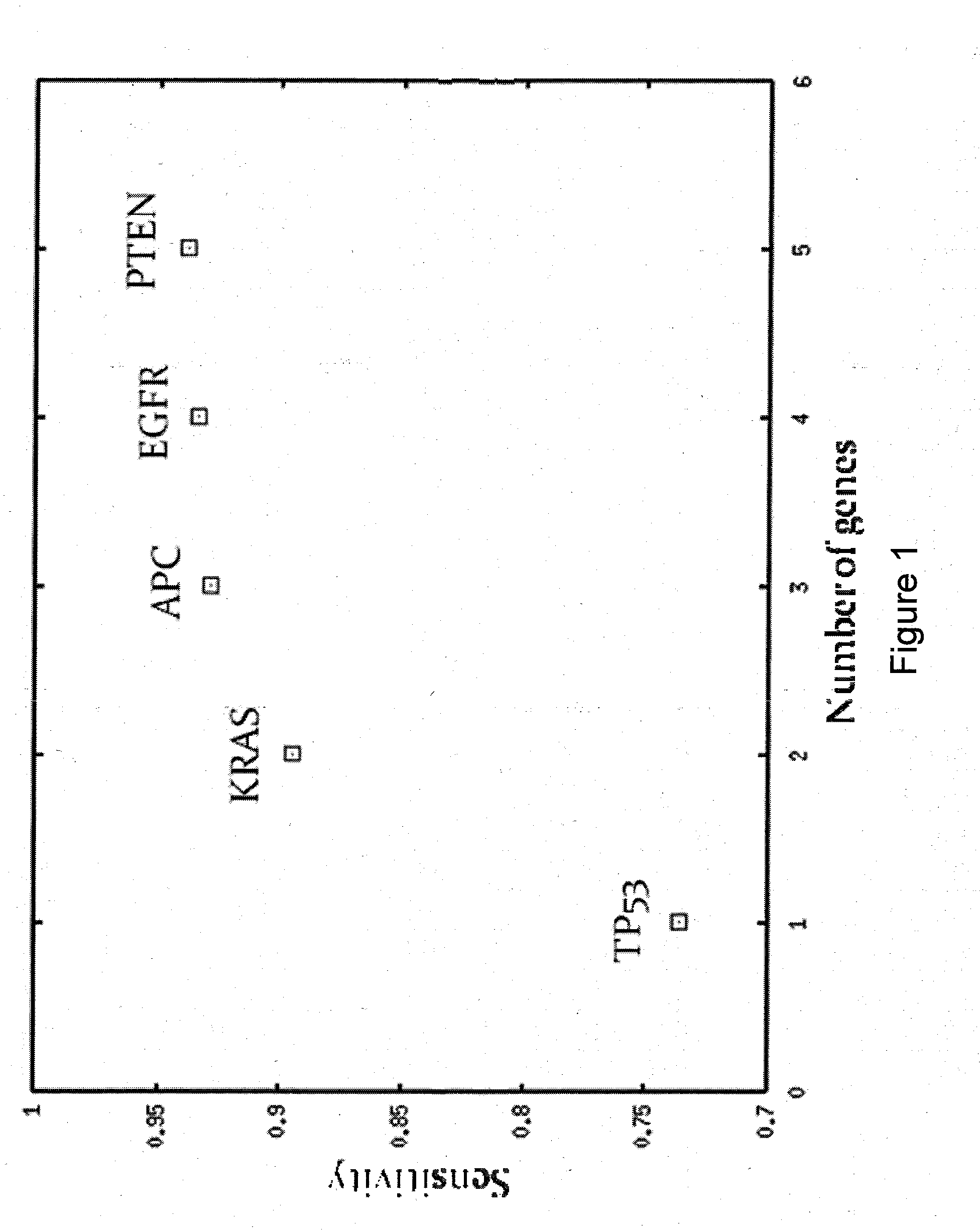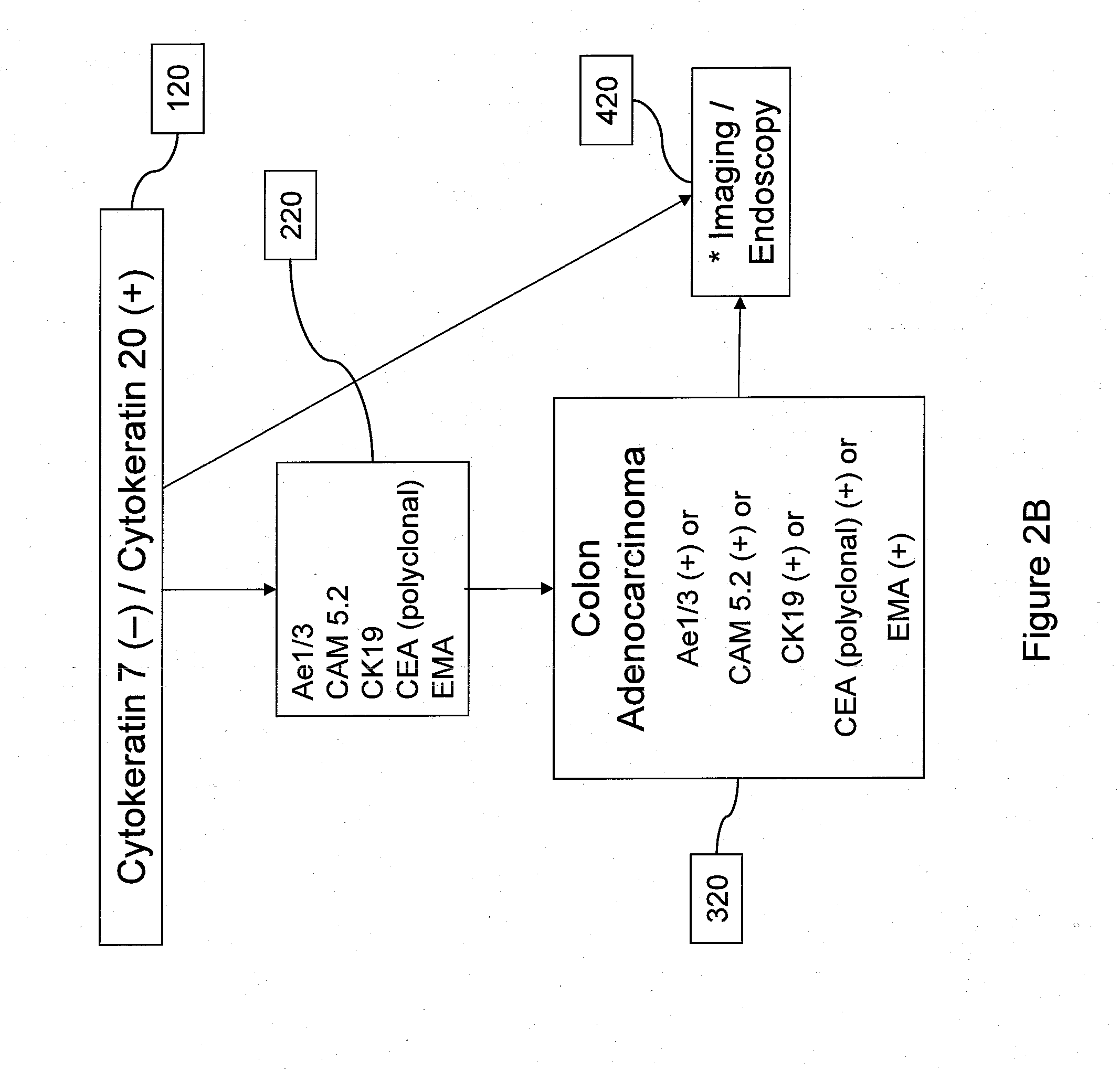Methods of detecting cancer
a detection method and cancer technology, applied in the field of molecular classification of diseases, can solve the problems of poor prognosis, major health challenges of cancer, and most vexing aspects of cancer remain early detection
- Summary
- Abstract
- Description
- Claims
- Application Information
AI Technical Summary
Benefits of technology
Problems solved by technology
Method used
Image
Examples
example 1
Using Somatic Mutations to Determine Tumor Site
Methods
[0103]Consider a sample from a patient with some type of cancer. The mutation screening of this sample identifies somatic mutations in n genes g1, g2, . . . , gn. Assuming that somatic mutations occur independently, the probability that this patient has cancer of type c is given by the following equation:
P(c|g1,g2, . . . ,gn)=P0(c)ΠiM(gi|c) / ΣtP0(t)ΠiM(gi|t) (1)
where the product is taken over all genes mutated in the sample (i=1, 2, . . . , n) and the sum is taken over all cancer types t. M(g|c) is the frequency of somatic mutations in gene g in cancer type c. See FIG. 3 (with mutation frequencies based on data from COSMIC [Catalogue of Somatic Mutations in Cancer] database). P0(c) is the a priori probability of cancer type c given that the patient has a cancer. See FIG. 4 (with these a priori probabilities based on cancer incidences published by the American Cancer Society). It should be noted that for some cancers (such as ovar...
example 2
Using Somatic Mutations to Detect Presence of Cancer
Method
[0122]Since somatic mutations are very specific to cancer or pre-cancerous conditions, the main performance measure of using mutation screening of a set of genes is its sensitivity. The sensitivity of screening for any cancer depends on sensitivities within individual cancers as well as on the incidences of the cancers. The sensitivity was defined by the following equation:
S=ΣtP0(t)S(t) (4)
where S(t) was the sensitivity within cancer type t. S(t) was defined as the percentage of patients with somatic mutations in one or more genes within a predefined set of one or more genes.
[0123]The following algorithm was used to define a small set of genes with high sensitivity:[0124]1. Started with all available samples and an empty list of genes.[0125]2. Within current set of samples, found the gene with highest sensitivity calculated according to Equation (4). This gene was added to the list of genes.[0126]3. Repeated Steps 1 & 2 unti...
example 3
Detecting Mutations in Exosomes
Method
[0134]To confirm our ability to detect cancer-related mutations in serum exosomes, cell culture supernatants (1-10 ml from ovarian and colon cancer cell lines) or ovarian and colon cancer patient serum samples (1-3 ml) were used to prepare exosomes by high-speed centrifugation. Total RNA was extracted from exosomal pellets and converted to cDNA by standard methods. PCR amplicons for a set of mutation hot spots in TP53, KRAS, EGFR and APC were designed and optimized for multiplexing. Exosomal cDNA was pre-amplified with a multiplex of all amplicons. The pre-amplification product was split into separate reactions and re-amplified with the individual target amplicons. Re-amplification primers were synthesized with tails for dye-primer sequencing. Individual PCR products were sequenced by dye-primer chemistry to identify particular mutations.
Results
[0135]Mutations were found in exosomes harvested from cell lines as follows:
TABLE 5ExosomalExosomalCell...
PUM
| Property | Measurement | Unit |
|---|---|---|
| frequency | aaaaa | aaaaa |
| threshold | aaaaa | aaaaa |
Abstract
Description
Claims
Application Information
 Login to View More
Login to View More - R&D
- Intellectual Property
- Life Sciences
- Materials
- Tech Scout
- Unparalleled Data Quality
- Higher Quality Content
- 60% Fewer Hallucinations
Browse by: Latest US Patents, China's latest patents, Technical Efficacy Thesaurus, Application Domain, Technology Topic, Popular Technical Reports.
© 2025 PatSnap. All rights reserved.Legal|Privacy policy|Modern Slavery Act Transparency Statement|Sitemap|About US| Contact US: help@patsnap.com



